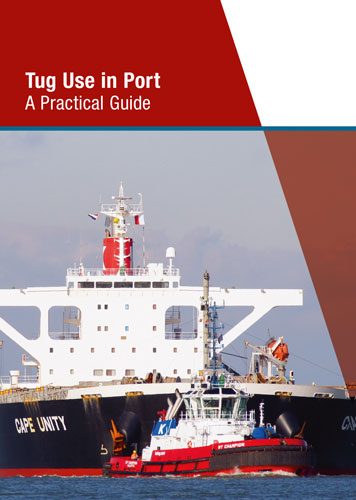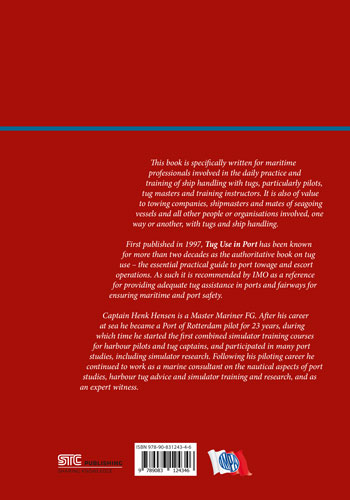Tug Use in Port. A Practical Guide/Использование буксиров в порту. Практическое руководство
Издание на английском языке
One of the most delicate responsibilities of pilots occurs during berthing and unberthing operations. Carefully berthing a ship, often after a long pilotage mission, is almost a work of art. Of critical assistance in this task is the support of tugs and their skippers. Today, this is probably true more than ever, as ships become ever larger, e.g., ultra large container vessels with their huge windage, while often being significantly less powerful or able to manoeuvre themselves in confined waters. These vessels may have proportionately smaller rudders coupled with engines that, often deliver less power, notably as a result of software-managed fuel consumption.
Contents
Foreword
Author’s preface
Acknowledgements
Glossary of terms
Tug Use in Port : The Overview
Chapter 1: Tug design factors
1.1 Differences in tug design and assisting methods
1.2 Factors influencing tug type and tug assistance
1.3 Types of tug
1.4 Assisting methods
1.5 Conclusion
Chapter 2: Types of harbour tug
Part A: Classification of tugs and operational design aspects
2.1 Classification of basic harbour tug types
2.2 Important general requirements for good tug performance
Part B: Basic tug types
2.3 Conventional types of tug
2.4 Combi-Tugs
2.5 Tractor tugs with cycloidal propellers
2.6 Tractor tugs with azimuth propellers
2.7 Reverse-tractor tugs
2.8 Japanese tug concept
2.9 Azimuth Stern Drive (ASD) tugs
2.10 Uni-lever system
Part C: Related tug types
2.11 Rotortug
2.12 Z-tech tug
2.13 RSD tug
2.14 Carrousel tug
2.15 DOT tug
2.16 The All-Rounder AR360T
Part D: Fast tug types
2.17 Introduction
2.18 SDM (Ship Docking Modules)
2.19 Eddy
2.20 Carrousel RAVE Tug (CRT)
2.21 Giano tug
Part E: Specific Tugs. Research. Performance
2.22 Tugs handling LNG carriers. LNG terminal tugs
2.23 Eco- tugs
2.24 Ice tugs
2.25 Research
2.26 Tug performance
Chapter 3: Assisting methods
3.1 Introduction
3.2 Assisting methods
3.3 Tug assistance in ice
3.4 Assisting Navy ships
Chapter 4: Tug capabilities and limitations
4.1 Introduction
4.2 Basic principles and definitions
4.3 Capabilities and limitations
4.4 Design consequences
4.5 Environmental limits for tug operations
4.6 Conclusions regarding tug types
4.7 Some other practical aspects
Chapter 5: Bollard pull required
5.1 Introduction
5.2 Factors influencing total bollard pull required
5.3 Bollard pull required
Chapter 6: Interaction and tug safety
6.1 Introduction
6.2 Interaction and shallow water effects
6.3 Tug safety
6.4 Summary and conclusions
6.5 Finally
Chapter 7: Towing equipment
7.1 Introduction
7.2 Additional towing points and gob ropes
7.3 Towing bitts, hooks and winches
7.4 Towline Safety Systems
7.5 Towlines
7.6 Towline handling
7.7 SWL ship’s towing equipment
7.8 Requirements for emergency towing equipment, escorting and pull-back
7.9 New emergency towing concept
Chapter 8: Training and tug simulation
8.1 Reasons for training
8.2 Various training objectives and tools
8.3 How specific training courses can be given
8.4 Assessment of further training needs
8.5 Developments
8.6 Conclusion
Chapter 9: Escort tugs
9.1 The background to escorting
9.2 Studies on escort requirements
9.3 Developments in escorting
9.4 Escorting objectives and tug placement
9.5 Escorting by normal harbour tugs
9.6 Escorting by purpose built tugs
9.7 Escort tug regulations
9.8 Concluding remarks
Chapter 10: Tug developments
10.1 Special developments in the design of tugs
10.2 Autonomous tugs
10.3 Developments in general
Chapter 11: Balancing safety
11.1 Introduction
11.2 Safety
11.3 Risks
11.4 Safety Management Systems
11.5 To summarise
References
Appendix 1: Guidelines for Owners/Operators on Preparing Emergency Towing Procedures
Appendix 2: Safety when handling tugs
Appendix 3: Stability Rules – Escort Tugs
Appendix 4: Standard Guide for Escort Vessel Evaluation and Selection
Appendix 5: Beaufort wind force scale
Index




